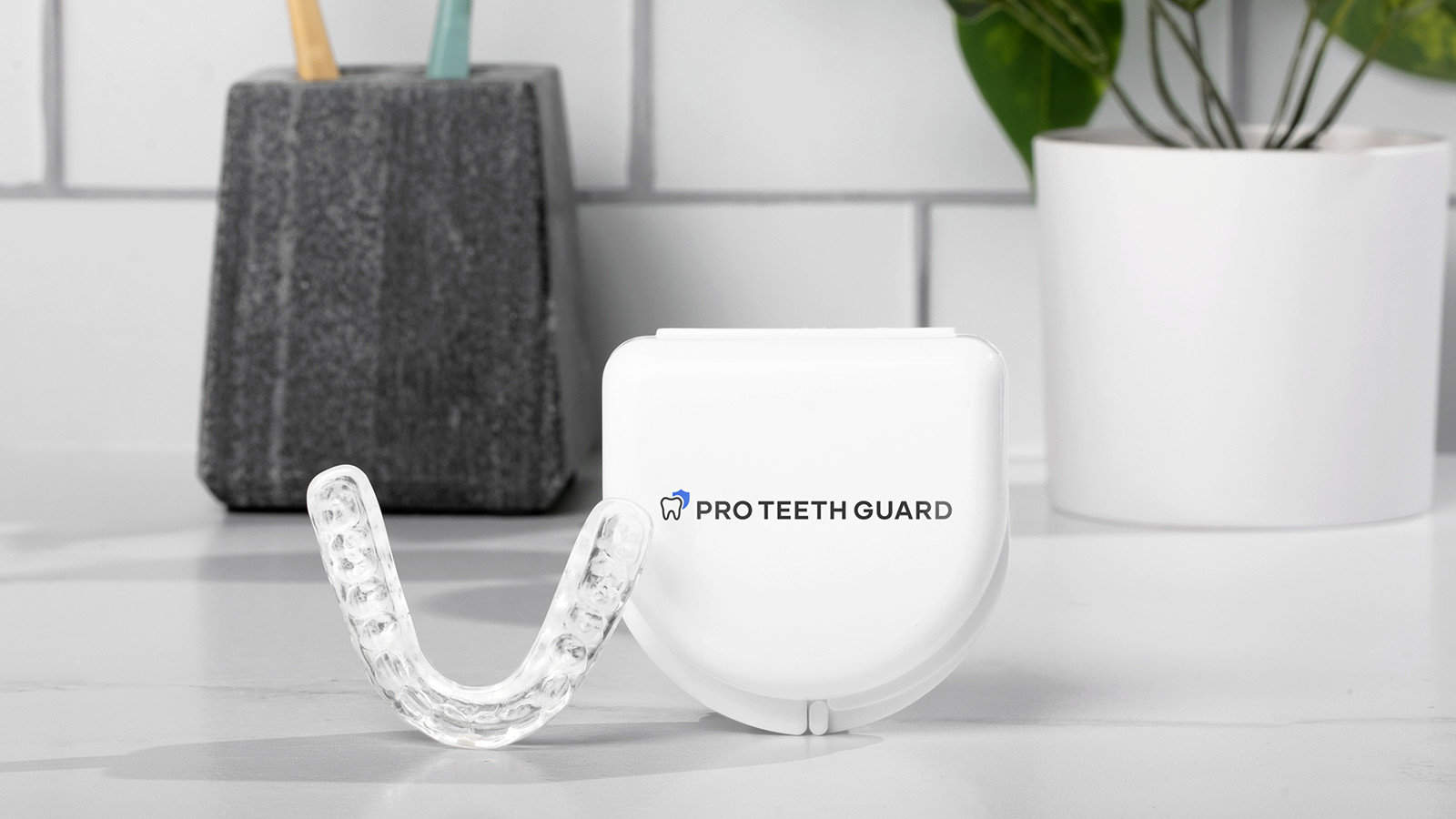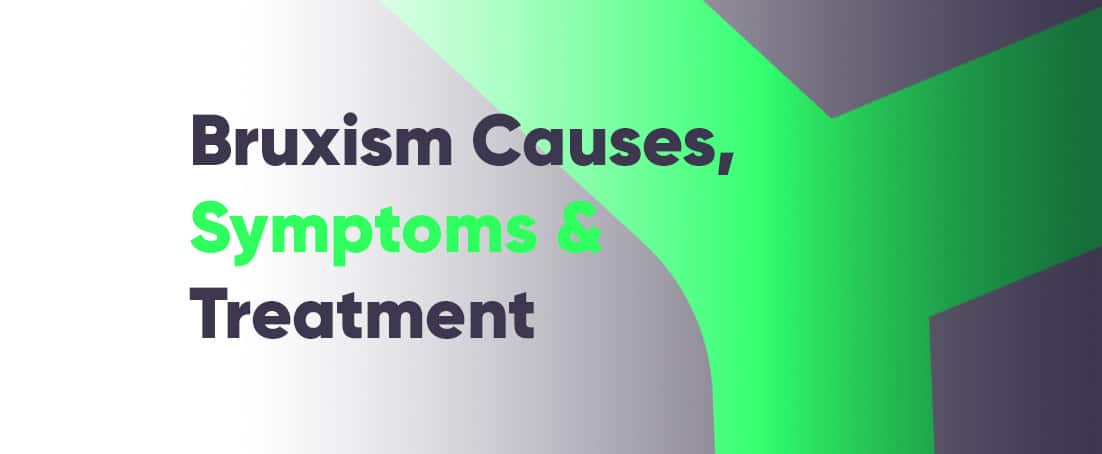Bruxism is a common condition characterized by involuntary teeth grinding or clenching. It’s when you constantly rub your teeth back and forth or sideways without even realizing that you are doing it, usually due to anxiety.
Just as you might brush off bruxism as a minor issue, think again. Research unequivocally demonstrates its potential for lasting harm, from dental damage to nagging jaw, head, or ear discomfort.
This article uncovers why you grind your teeth, what signs to watch for, and how to treat bruxism. It puts you in control of your oral health, protecting your teeth and ensuring you get a good night’s sleep.
Table of Contents:
What is Bruxism?
Bruxism refers to the habitual, often unconscious, grinding or clenching of teeth. The term originates from the Greek word “brychein,” meaning “to grind.” In today’s fast-paced society, elevated stress levels have made bruxism a more pervasive issue than ever before. Bruxism manifests in two forms: awake bruxism and sleep bruxism.
When you experience semi-voluntary jaw clenching throughout the day, you may be dealing with Awake bruxism, a condition often linked to elevated stress levels.
Sleep bruxism, characterized by involuntary jaw movements or teeth gnashing while asleep, poses a significant dental health concern. Its prevalence is notably higher among children, emphasizing the importance of early detection and intervention.
These two types can have different symptoms and underlying causes. For instance, awake bruxism might not produce any noticeable dental damage but can result in jaw pain and headaches. Sleep bruxism, conversely, can lead to significant dental wear and even fractures. Distinguishing between these two forms is vital for effective treatment.
Causes Of Teeth Grinding (Jaw Clenching)
While scientific research highlights social influences and personal habits as primary triggers for Bruxism, other factors can contribute as well. Stress and anxiety tend to fuel this condition, while sleep disorders like sleep apnea can also play a role. Lifestyle choices like consuming caffeine or smoking can worsen the situation.
There are risk factors for bruxism, such as age, genetics, and certain medications that can contribute to bruxism. It often starts during childhood, adolescence, or young adulthood, with genetic predispositions potentially influencing its development. Medications used for treating ADHD may also increase the likelihood of bruxism, a condition associated with teeth grinding.
Types Of Bruxism
As previously noted, bruxism manifests in two primary forms: awake and sleep bruxism.
Bruxism can be primary or secondary. While Primary Bruxism has no specific underlying cause, Secondary Bruxism is linked to other conditions like sleep disorders or medication use. Understanding the types of Bruxism is crucial for accurate diagnosis and tailored treatment approaches
Awake Bruxism (Diurnal Bruxism)
Awake bruxism, also known as daytime bruxism, refers to the habit of clenching or grinding teeth during waking hours. Unlike sleep bruxism, which occurs unconsciously during sleep, awake bruxism is more noticeable and voluntary. People with awake bruxism may clench their teeth during stressful situations while concentrating, or when feeling anxious.
Sleep Bruxism (Nocturnal Bruxism)
Sleep bruxism, also known as nocturnal bruxism, occurs during sleep stages. It involves rhythmic or non-rhythmic muscular activity, such as clenching or grinding teeth, often without conscious awareness. Risk factors include stress, anxiety, and arousal during sleep. Understanding this type is crucial for effective diagnosis and tailored treatment approaches.
Primary vs. Secondary Bruxism
Primary bruxism is not related to any other medical condition. It occurs independently without any specific underlying health issue. On the other hand, Secondary bruxism is associated with other medical conditions. It can be a consequence of neurological disorders such as Parkinson’s disease, dementia, and epilepsy, or Sleep disorders like sleep apnea, night terrors, and other sleep-related issues. Some psychiatric drugs may lead to bruxism. Other factors include stress, age, aggressive personality, and genetics.
Individuals with primary bruxism grind their teeth involuntarily and excessively. This can happen during both wakefulness (diurnal bruxism) and sleep (nocturnal bruxism). Primary bruxism can be managed with the use of mouth guards or occlusal splints and behavioral approaches such as relaxation techniques, lifestyle adjustments, and sleep hygiene instructions.
To treat Seconary Bruxism, identifying and treating the underlying cause is necessary for effective management.
Diurnal vs. Nocturnal Bruxism
Diurnal bruxism occurs while a person is awake, during daytime hours, while Nocturnal bruxism occurs during sleep. People with diurnal bruxism forcefully grind or clench their teeth, often semi-voluntarily. In contrast, people with nocturnal bruxism unconsciously grind or clench their teeth at night. Signs of nocturnal bruxism include worn tooth enamel, jaw soreness, and sometimes disrupted sleep of the sufferer and their partner.
Treatment approach for Diurnal bruxism include behavioral awareness, encouraging patients to be aware of their teeth grinding habits during the day. Stressors that might be causing awake bruxism should be addressed. Occlusal splints (custom-made mouthguards) are commonly used to protect teeth from further damage during waking hours.
On the other hand, the treatment of Nocturnal bruxism involves using nighttime occlusal splints, which are similar to daytime, but these are specifically designed for nighttime use. Additionally, relaxation techniques can be used to help patients unwind and reduce tension.
Symptoms Of Grinding Your Teeth
Jaw Clenching
Jaw clenching is often mistaken for teeth grinding, but the key difference is that you can clench your jaw at any point in the day, not just during sleep. The action places an extreme amount of pressure on the jaw joint and the surrounding muscles.
This tension can lead to muscular pain and may also contribute to TMJ disorders. Regular clenching impacts your jaw’s health, causing long-term damage if left unaddressed.
Headaches
One of the most common and disruptive symptoms of bruxism is headaches. When you grind or clench your teeth, the muscles in your jaw and neck tense up. This muscle tension propagates to the head, manifesting as a headache. This tension headache can worsen throughout the day, especially if clenching continues while awake.
If you experience frequent headaches, particularly upon waking or after periods of stress, discussing bruxism with your dentist or doctor can help determine if it’s the culprit and explore treatment options to ease the pain and protect your teeth.
Earaches
While it may seem unrelated, earaches can be a direct outcome of bruxism. The temporomandibular joint, located near the ear canal, bears the force exerted during grinding and clenching. The stress on this joint can subsequently cause discomfort or pain to radiate into the ear. Therefore, earaches could be an important sign that you’re grinding or clenching your teeth too much.
Temporomandibular Joint (TMJ) Disorders
Temporomandibular Joint (TMJ) disorders pertain to a range of issues affecting the joint that links the jaw to the skull. This joint is fundamental for activities such as speaking, eating, and yawning. When impacted by bruxism, the symptoms can range from mild to severe. More severe symptoms can escalate to pronounced pain, a locked jaw, and even difficulty in moving the jaw at all.
Mouth guards address a key aspect of both TMJ and bruxism – preventing clenching and grinding. They act as a protective layer between your upper and lower teeth, effectively reducing the pressure on the TMJ. Other treatment paths like physical therapy, pain relief medications, or even surgery in extreme cases exist, but mouthguards are widely accepted as the first line of defense. We also suggest to include TMJ jaw exercises for pain relief.
Increased Tooth Sensitivity
Increased tooth sensitivity is a noticeable outcome of chronic bruxism. This sensitivity originates from the wearing away of the enamel, which is the tooth’s protective layer. As the enamel thins, the dentin layer underneath becomes exposed. Dentin contains microscopic channels leading to the tooth’s nerve center, making the teeth more susceptible to stimuli like hot or cold temperatures.
The severity of tooth sensitivity can range from a mild tingling sensation to sharp, intense pain. For some, the discomfort could be fleeting, while for others, it could linger and significantly affect the quality of life.
Desensitizing toothpaste, which contains compounds that block the transmission of pain signals, is a great treatment option. However, the most effective preventive measure for tooth sensitivity caused by bruxism is often a custom-fitted mouth guard.
Teeth Damage
The ramifications of untreated bruxism include substantial damage to the teeth. The constant grinding can cause fractures, loose teeth, and even tooth loss. Dental associations have confirmed that failure to manage bruxism effectively can lead to severe dental issues, which might necessitate extensive and costly treatments.
Cheek and Tongue Biting
While less discussed, cheek and tongue bites are also indicative of bruxism. The excessive force generated during grinding or clenching can cause accidental bites, leading to ulcers and sores. These sores are not only painful but also prone to infections, necessitating prompt attention and care. To reduce symptoms and mitigate further injuries, you can use a mouth guard for tongue biting.
Bruxism Treatment Options
#1. Mouth Guards for Bruxism

Pro Teeth Guards offer professional-quality, custom-fit mouthguards designed to alleviate the discomfort of bruxism without breaking the bank. With various categories to choose from, finding the perfect Pro Teeth Guard tailored to your specific needs has never been easier.
Check Price >>Mouth guards, also known as night guards or occlusal splints, are widely used to manage bruxism. These custom-fitted devices act as a protective barrier between your upper and lower teeth. Made of durable plastic material, they absorb the force generated during teeth grinding or clenching, preventing wear and damage. Mouth guards promote jaw muscle relaxation, reducing strain.
Types of Mouth Guards:
- Soft Night Guards: Made of flexible materials, suitable for mild bruxism.
- Hard Night Guards: Sturdier, ideal for moderate to severe cases.
- Dual Laminate Guards: Combining soft and hard layers for optimal comfort and protection.
- Bite Splints: Used during the day for diurnal bruxism.
Night guards are the go-to solution for tackling nocturnal bruxism, effectively safeguarding teeth while you sleep. Custom-made guards reign supreme in this arena, ensuring a snug fit and delivering optimal protection. To find the perfect match for your needs, consulting your dentist is key—they’ll assess your situation and recommend the most suitable type of guard tailored to your requirements.
To narrow down your search, we recommend you to go for Pro Teeth Guard, which is one of the best TMJ mouth guard that is a custom fitted, professionally made night guard for teeth grinders. You can order Pro Teeth Guard from the convenience of your home.
Remember, addressing bruxism early with appropriate treatment can safeguard your dental health and overall well-being. If you suspect bruxism, consult your dentist for personalized guidance and the best TMJ mouth guard.
#2. Dental Correction
Traditional braces or clear aligners can gradually move teeth into proper alignment, improving your bite. In some cases, crowns, fillings, or other restorations can improve the fit and function of your teeth, reducing stress on your jaw and potentially reducing bruxism.
Consulting with a dentist is crucial for diagnosis and treatment. They can assess whether you need to correct jaw alignment with braces or other dental procedures.
#3. Stress Reduction Techniques
Managing stress effectively can make a big difference in controlling bruxism. Practices like mindfulness and relaxation exercises (such as deep breathing and muscle relaxation techniques), can all help you better handle stressors in your life.
Additionally, therapy, such as cognitive-behavioral therapy (CBT), can provide individuals with coping mechanisms and strategies to better handle stressors, ultimately reducing the likelihood of bruxism episodes.
And don’t forget about lifestyle changes! Regular exercise, good sleep habits, and a balanced diet can work wonders in reducing stress levels and improving symptoms of bruxism.
#4. Botox Injections for Bruxism
In severe bruxism cases, Botox therapy can be a treatment option. Botox injections relax the jaw muscles, particularly the masseter, reducing the grinding force.
The procedure involves injecting small amounts of botulinum toxin into the jaw muscles. While generally safe, potential side effects include temporary bruising, swelling, and mild facial weakness.
Botox therapy for jaw clenching offers temporary relief, typically lasting 3-6 months. Discuss with a doctor if it’s right for your bruxism treatment plan.
#5. Connection Between Sleep Apnea and Bruxism
There’s a strong connection between sleep apnea and teeth grinding (bruxism). Sleep apnea is a serious sleep disorder where breathing is interrupted during sleep. It can lead to multiple awakenings, reduced oxygen flow, and heart rhythm issues. During sleep apnea episodes, struggling to breathe can strain your body, including jaw muscles, leading to bruxism.
Treating sleep apnea can indirectly reduce bruxism. Continuous Positive Airway Pressure (CPAP) is the gold standard treatment for sleep apnea. You can also opt for oral appliance therapy with mouthpieces, which help keep the airways open while protecting teeth from grinding.
#6. Medication
Medications like muscle relaxants or antidepressants may be prescribed to manage bruxism symptoms. These medications can help reduce muscle tension or alleviate pain associated with bruxism. However, medications can have side effects, and their use should be discussed with a doctor to determine if they’re right for your treatment plan.
#7. Biofeedback Therapy
Biofeedback offers a non-invasive treatment option for bruxism. It is a behavioral approach to bruxism management. It uses sensors to monitor muscle activity, helping you become aware of clenching and grinding. A scientific study suggests that with biofeedback training, you can learn to relax your jaw muscles, reducing bruxism episodes over time.
#8. Nutritional Supplements
Supplements like magnesium or vitamin B complex may be helpful for bruxism. These supplements may support muscle relaxation (magnesium) or overall oral health (vitamin B complex), potentially reducing bruxism symptoms.
However, consult a doctor before taking any supplements to determine if they’re right for you and address any potential deficiencies through diet first.
#9. Combination Therapies and Comprehensive Approach
For effective bruxism management, combining treatments can be beneficial. A comprehensive approach addresses both physical (e.g., splint therapy) and psychological aspects (e.g., stress management). Encouraging good sleep hygiene and relaxation techniques can also be beneficial in addressing bruxism.
Collaboration among dentists, sleep specialists, and mental health professionals can optimize bruxism treatment. This combined approach can target the root causes and provide better long-term relief.
3 Tips To Prevent Teeth Grinding
1. Do Regular Dental Check-ups
Regular dental check-ups are essential for monitoring dental health and identifying early signs of Bruxism, as the constant rubbing of teeth causes damage. Dental professionals play a key role in managing this condition by examining for wear patterns on teeth indicative of grinding. They recommend protective devices like mouthguards to prevent damage. Moreover, they advise on lifestyle changes to reduce bruxism triggers.
2. Avoid Stimulants
Reducing the intake of stimulants like caffeine, nicotine, and alcohol is crucial for preventing teeth grinding. Here are some tips:
- Gradually decrease consumption to minimize withdrawal symptoms.
- Substitute with healthier options like decaffeinated drinks or herbal teas.
- Avoid stimulants close to bedtime to improve sleep quality.
- Explore stress-reduction techniques such as meditation or exercise as alternative coping mechanisms.
3. Try Stress Management Techniques
Incorporating stress management techniques into your daily routine is vital for mitigating bruxism. Strategies include mindfulness, which is the practice of being present to reduce anxiety. You can try relaxation exercises, using techniques like progressive muscle relaxation to ease tension.
Furthermore, you can seek professional therapy to develop coping strategies.
F.A.Q.
What are the complications of untreated bruxism?
Untreated bruxism can lead to tooth damage, jaw disorders, headaches, temporomandibular joint disorders, and facial pain.
Can children have bruxism?
Yes, children can experience bruxism, especially during teething or stressful periods. Although many outgrow it without lasting problems.
Is bruxism related to other sleep disorders?
Bruxism may be associated with sleep disorders like sleep apnea or restless leg syndrome.
Summing Up Bruxism
Bruxism refers to the habitual tooth clenching, grinding, or gnashing of teeth, which can happen both during waking hours and while asleep. Awake bruxism is characterized by teeth grinding or clenching during the day, and sleep bruxism occurs at night.
Each type has unique triggers and effects, necessitating precise diagnosis for tailored treatment plans. Treatment options for bruxism include mouthguards, stress management techniques, and in severe cases, Botox injections.
It’s imperative for those affected by bruxism to pursue professional assessments to identify the specific type and receive targeted management strategies, ensuring comprehensive care for this multifaceted condition.

